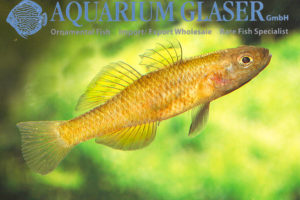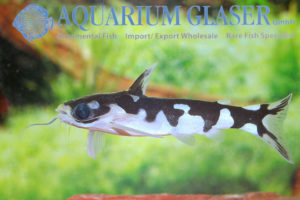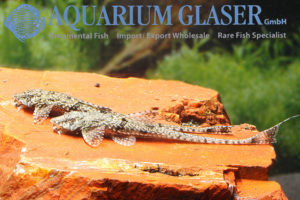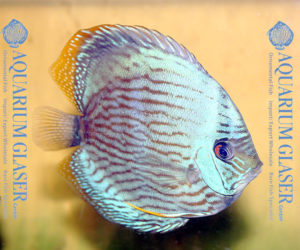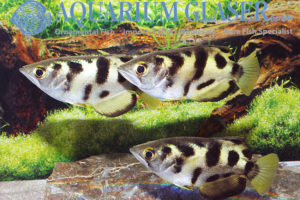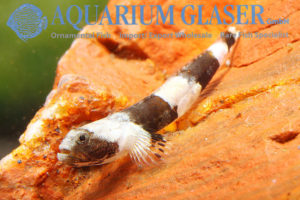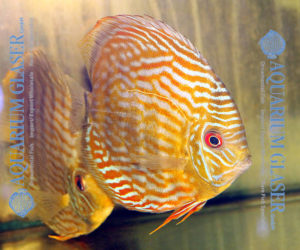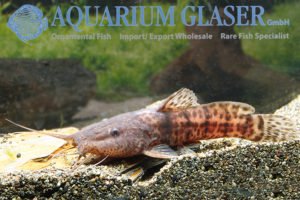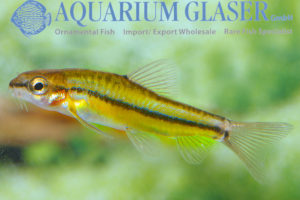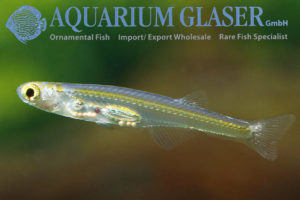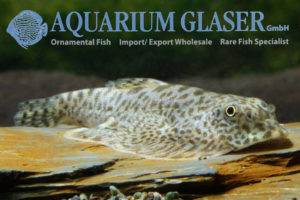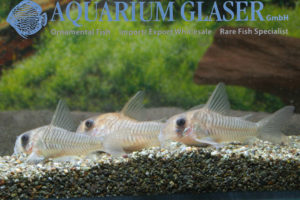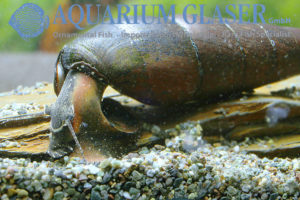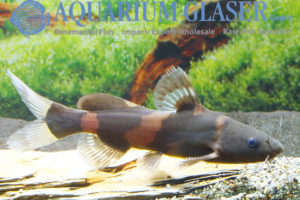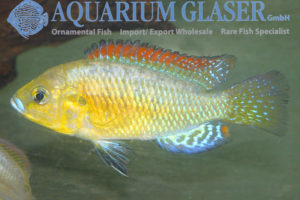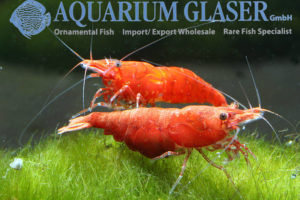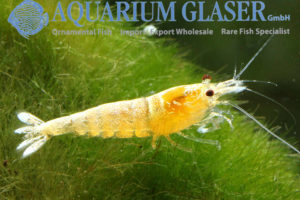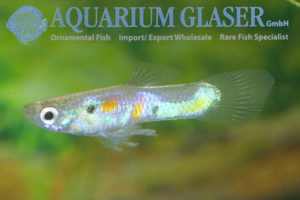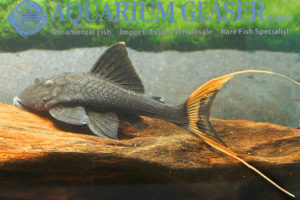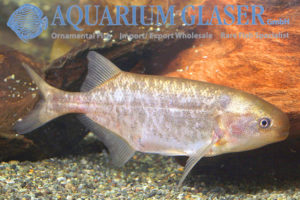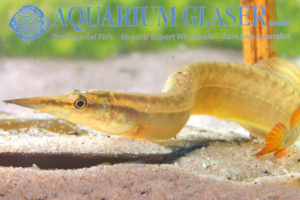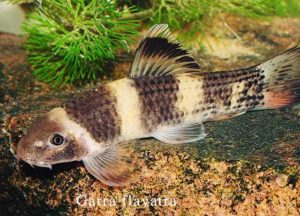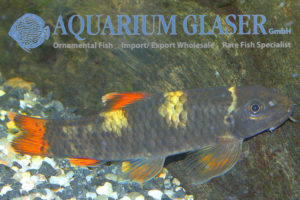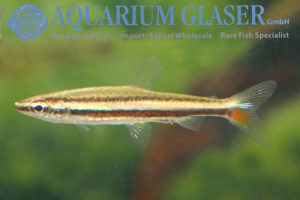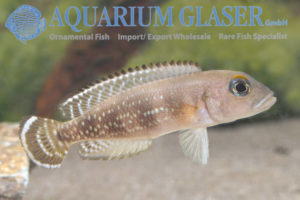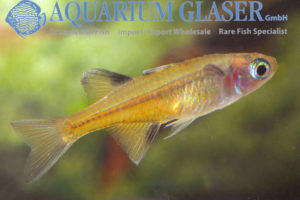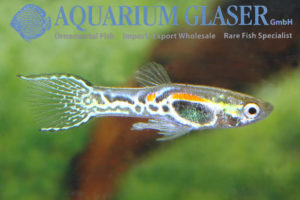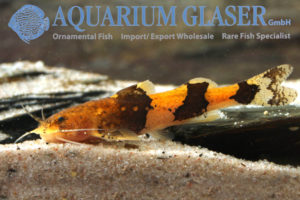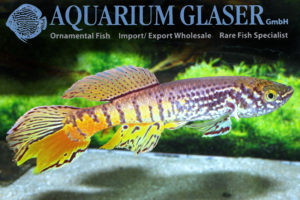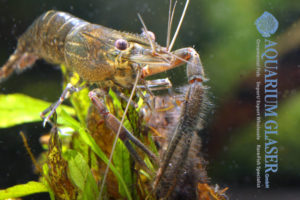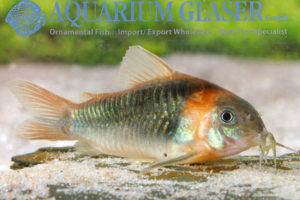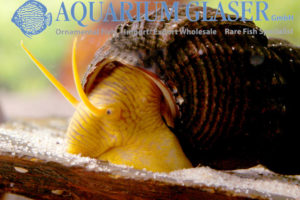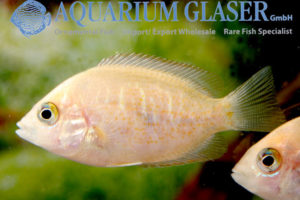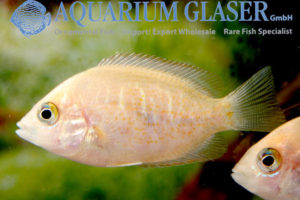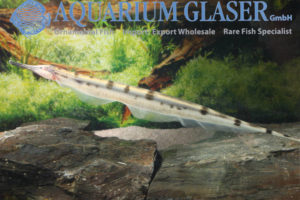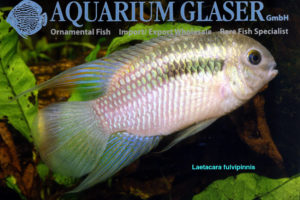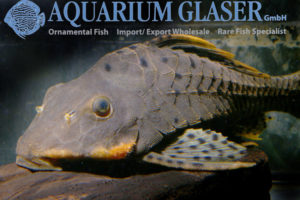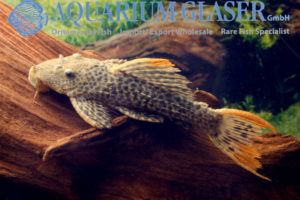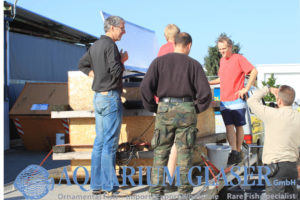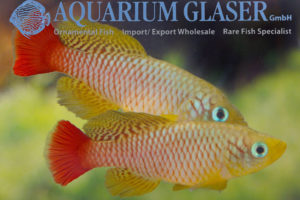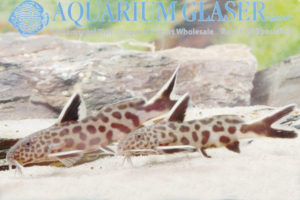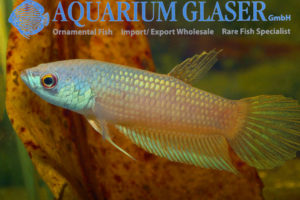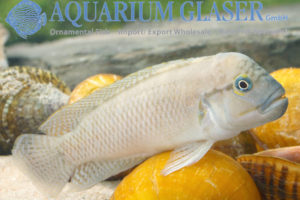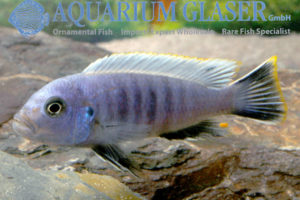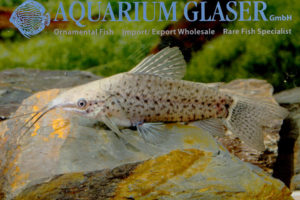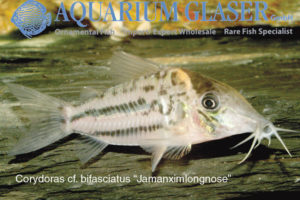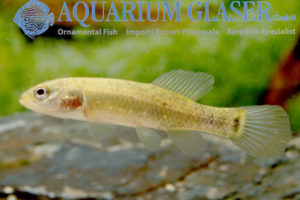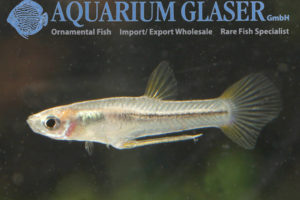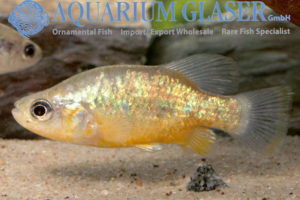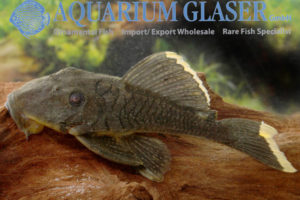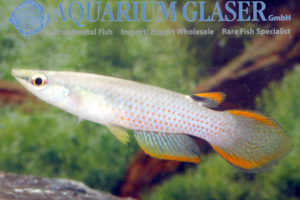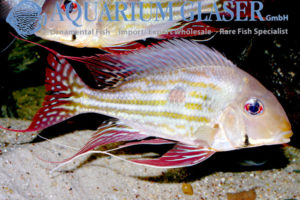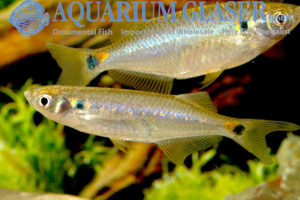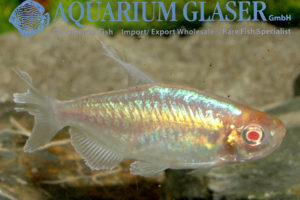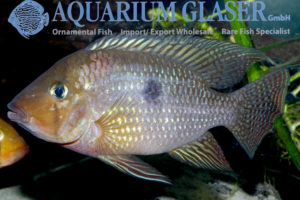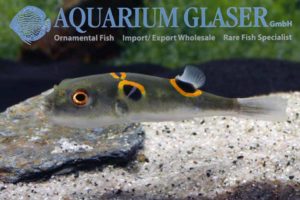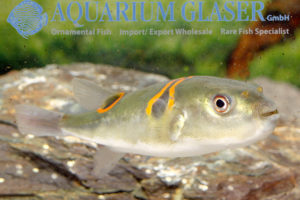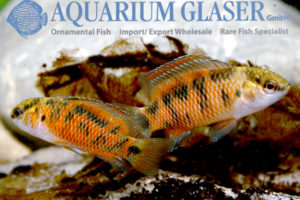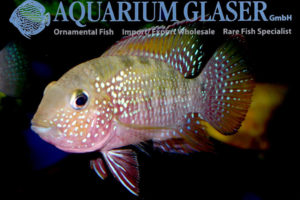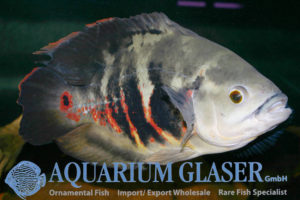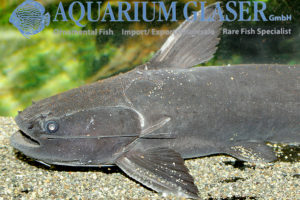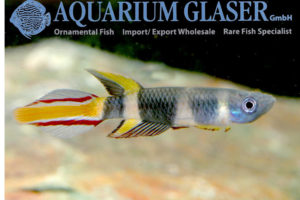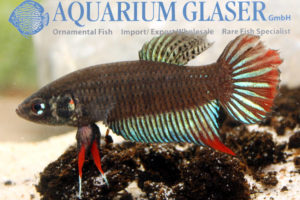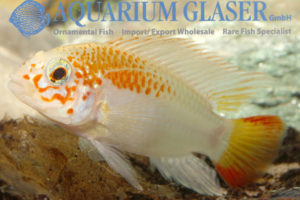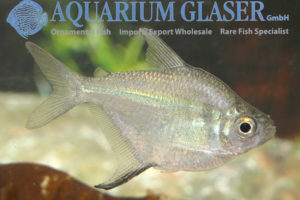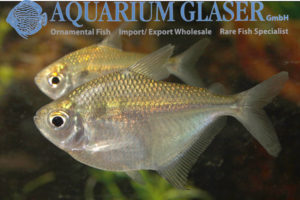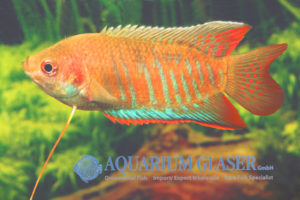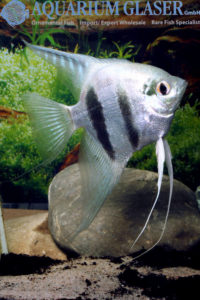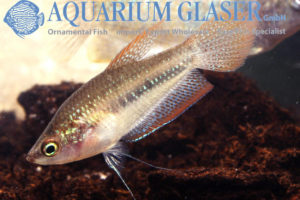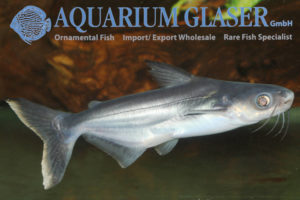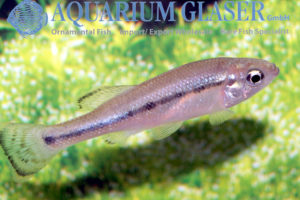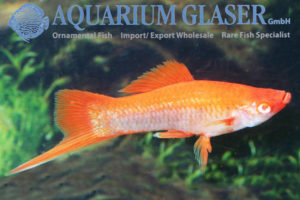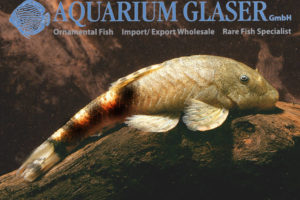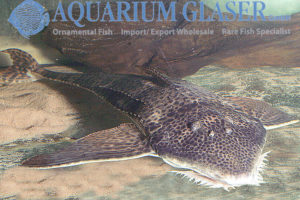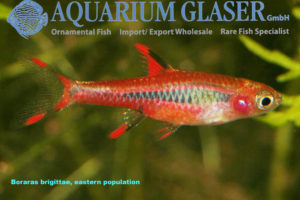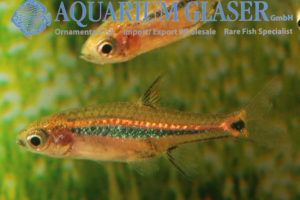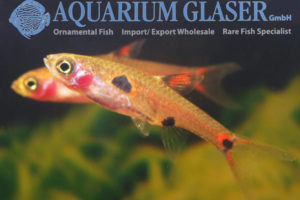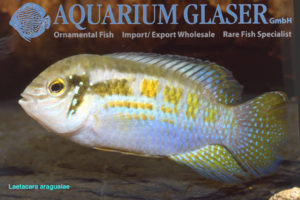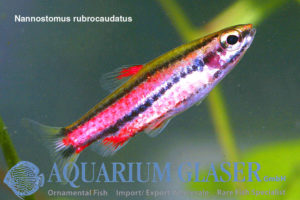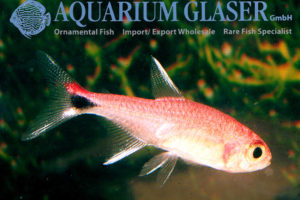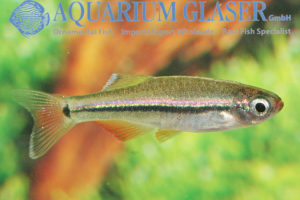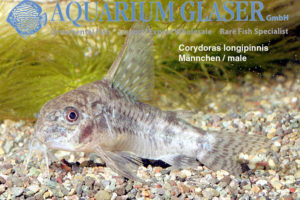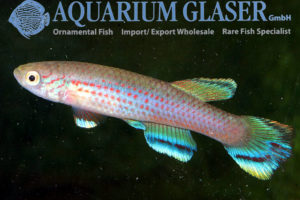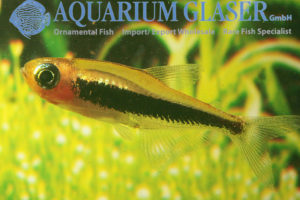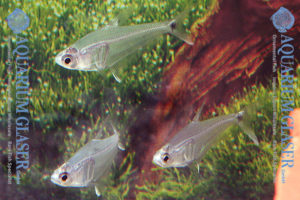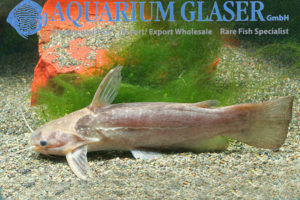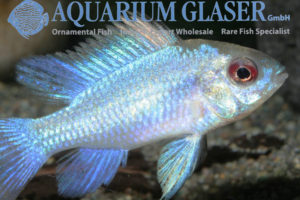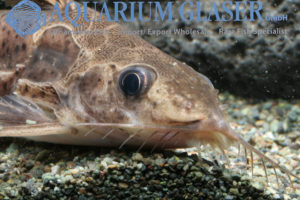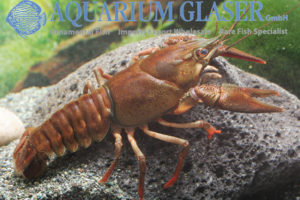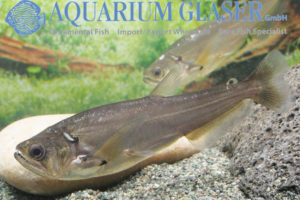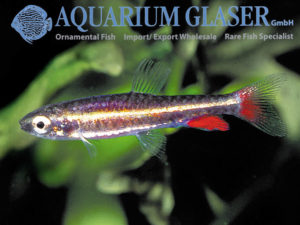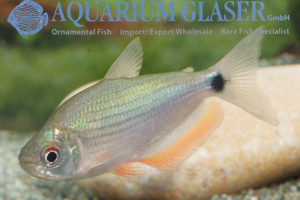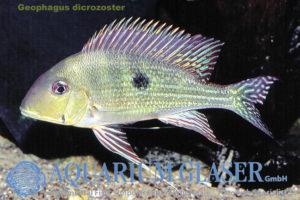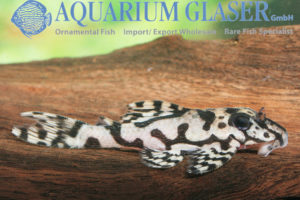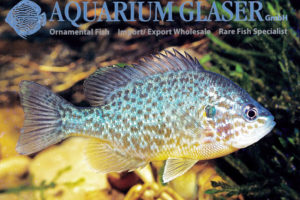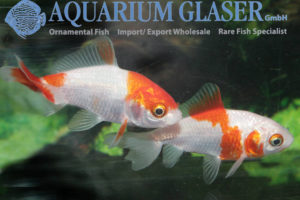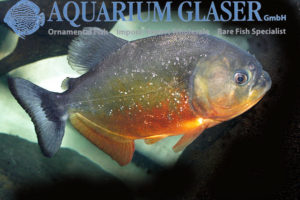This small, yellow goby is a free swimming species, in contrast to most of the other gobies. Maximum length is about 4-5 cm. Territorial males become bright yellow and also develope larger fins with dark bands. Females are much paler in coloration and have translucent fins. The species is restrictet to Sulawesi and even on […]
Fish Archive (3126)
-
-
Centromochlus sp. Ninja (= C. orca)
A small sensation reached us recently from Brazil. Already when the small (4-6 cm long) catfish were unpacked their brillant black-and-white-pattern was a real eyecatcher. The fish definetely belong to the genus Centromochlus, which currently comprises 11 species in South America. These fish are close relatives of the better known genus Tatia and belong (like […]
-
Hemiloricaria beni
Now we can offer the smallest known species of whiptail catfish: Hemiloricaria beni. It hardly becomes longer than 8 cm. As this species occurs only in Bolivia and no commercal exportations from Bolivia appear, we offer only bred ones. Initially Swiss aquarists collected this species on a private collecting trip in 1997. Since then a […]
-
Discus Heckel / Jatapu
The series of astonishing wild collected discus we are able to offer right now does not break off. Besides the wonderful Royal Blue which we introduced to you last week, we also have excellent Heckel blue-head said to come the Jatapu river. This branch of the Amazon river has an unique mix of fauna found […]
-
Toxotes sp. New!
A new species of Archerfish! Recently we received a shipment containing archerfishes (Toxotes) from Thailand. Most of the shipment were T. jaculatrix (see http://www.aquariumglaser.de/en/toxotes-jaculatrix_en_1076.html) and some T. chatareus (see http://www.aquariumglaser.de/en/toxotes-chatareus_en_1044.html). But a closer look showed also four specimens of an unique colored archerfish, which we have never seen so far and which fits to none […]
-
Schismatogobius ampluvinculus
We received for the first time now this cute goby from Taiwan. Especially when it is in the right mood it looks extremely pretty due to its contrasting black-and-white coloration. One of the generic characteristics of Schismatogobius is the fact that they have an individual coloration: there are not even two specimens with the exact […]
-
Discus Royal Blue Novo Ariguana
Yesterday (2.2.) we received breathtaking beautiful large wild collected discus called Discus Royal Blue Novo Ariguana. All insiders will understand that the fish do not show all of their beauty today, but even what they show is amazing! Text & photo: Frank Schäfer
-
Parauchenoglanis punctatus
Parauchenoglanis punctatus: Among the imports from central Africa this beautiful catfish is a real rarity. It is known so far only from the central Congo basin. From that region only few fish are imported regulary. The species attains a length of approximately 40 cm. Thus it is a perfect tankmate for show aquaria with larger […]
-
Yunnanilus sp.
The genus Yunnanilus comprises a comparably high number of species: 30 species are currently recognized as valid, but there are for sure much more species. Most known species have a very small distribution area. If you realize that only a very small part of the waters in the area of the genus have ever been […]
-
Danionella dracula
Danionella are extremely small cyprinids, which never grow larger than 2 cm. The species that was discovered first – Danionella translucida – was thought to be the smallest cyprinid in the world, until the even smaller genus Paedocypris was discovered. Currently, four species are recognized by science, three from Burma and one from northern India. […]
-
Sewellia speciosa
Currently we were able to import this nice hillstream loach from Laos for the first time. The species is restricted to the Kong river influence in Laos and Vietnam. Maximum length is around 6 cm. The species has a very interesting sexual dimorphism. Males – which are in general more tiny than females – develope […]
-
Corydoras sp. C40
This pretty cory comes from the Brazilian state of Rondonia. It is not possible to distinguish the fish from Corydoras griseus externally. However, Corydoras griseus comes from Guyana and between the collecting sites of both species are serveral thoundands of kilometers. So it was decided to wait until a scientist has researched the identity of […]
-
Faunus ater
This attractive, about 6 cm long snail currently reached us from Thailand. It is a relative of the well known Malayian trumpet snail. In the wild this animal occurs in the lowest reaches of rivers on muddy bottoms and is thus very tolerant against salt. So it is possible to keep it in freshwater tanks […]
-
Pseudomystus siamensis (= Leiocassis siamensis)
It has been some time that we had this good old fashioned classic from Southeast Asia in our fishhouse. Pseudomystus siamensis originates from Thailand, Cambodia, and Laos and is a smaller species of catfish. Maximum length given in literature is 15 cm, but this length is hardly ever reached. Against congeneers and other species of […]
-
Pseudocrenilabrus multicolor victoriae
This extreme beautiful small cichlid has changed its name quite often. Initially it was introduced to the hobby under the name Pseudocrenilabrus philander dispersus. The natural distribution area of this subspecies is Uganda. Only bred specimens are traded. The fish are agamous maternal mouthbrooders, which means that the males and the females do not build […]
-
Neocaridina heteropoda BLOOD RED
There are always new cultivated varieties of freshwater dwarf shrimp appearing in the market. It is already difficult to determine the exact scientific identity of wild shrimps, it is almost impossible in cultivated ones. The animals imported under the name Neocaridina heteropoda BLOOD RED from Taiwan are a real alternative to the difficult to keep […]
-
Neocaridina RED-BEE-SNOW-WHITE-SHRIMP
We already introduced this beautiful animal to you: http://www.aquariumglaser.de/en/neocaridina-red-bee-snow-white-shrimp_en_1081.html. Now we have it again in stock, once more the beauties come from Taiwan. For our customers: the shrimps have code 485340 on our stocklist. Please note that we exclusively supply the wholesale market. Text & photos: Frank Schäfer
-
Poecilia reticulata Guppy Jamaica
The guppy is one of the most important ornamental fishes. Besides the numerous cultivated varieties the wild forms become more and more popular in the hobby. We offer several of these wild forms, one of the most beautiful is the so-called Jamaica-variety. However, the fish are bred for us by professional breeders in Europe. In […]
-
Panaque L90a Ojo Chico
L90 is a very variably colored species. This year we received very nice animals which have the bright halfmoon in the caudal fin orange red instead of white. The Spanish name (ojo = eye, chico = boy) does not emphasize on the coloration, but on the small eye which distinguishes L90 from other members of […]
-
Brienomyrus niger
There are about 200 species of Mormyridae (Elephantfishes) in Africa. Some of them belong to the most important freshwater fish species of the continent, due to their abundance and good taste. In the aquarium hobby, on the other hand, mormyrids are only rarely seen. All mormyrids belong to the weakly electrical fishes and communicate on […]
-
Macrognathus meklongensis
We were able to import for the first time one of the smallest and most beautiful species of spiny eel: Macrognathus meklongensis from Thailand.This charming species becomes hardly 15 cm long and only as thick as a forefinger. The coloration differs very much depending on mood. The basic colour is a nice golden bonze, the […]
-
Garra flavatra
Now available again! We are pleased to be able to offer you Garra flavatra. Their attractive pattern as well as their reddish fins make it the most beautiful Garra species. In our first news (see news v. 16.12.05) it was offered under the trade name Garra spec. “Panda”, in the meantime resulted the species affiliation […]
-
Garra flavatra
The algae-eating suckermouth barb Garra flavatra from Burma is a quite beautiful fish. In contrast to all other species of algae-eaters this is a species which is kept due to its own attractivity. In our show-room the fish now revealed a secret they kept so far: they develope deep red fins! Keeping Garra flavatra is […]
-
Subscription of our newsletter works again
Dear visitor, sadly we became aware only now that for some days the link for subscription of our free newsletter did not work. We were able to solve the problem and apologize for all those who gave up frustrated. Sincerely yours, the team of Aquarium Glaser Picture: Fehlerteufelchen © by Hidenori Nakano, 2009
-
Nannostomus digrammus
The pencilfishes (Nannostomus) belong to the most beautiful tetras. Besides their nice coloration their swimming stile makes them so attractive. It reminds one always of a miniature airship. Nannostomus digrammus is a rarely imported species. It looks quite similar to the common N. trifasciatus. However, the eponymous third black stripe on the belly, which is […]
-
Neolamprologus meeli
Among the snail-dwelling cichlids of Lake Tanganyika are some species that look very much alike and in some cases it remains still unclear whether the scientific name applied on them is correct or not. Neolamprologus meeli has been described in 1948 by Max Poll from a place near Katibili which belongs to the Congolese part […]
-
Pseudomugil signifer
The species of the genus Pseudomgil are relatives of the rainbowfishes. But they stay much smaller and usually they reach only 4-5 cm in length. This is also true for P. signifer, which looks a bit like a miniature edition of the Celebes rainbowfish (Marosatherina ladigesi). The males are displaying the whole day through what […]
-
Guppy Endler “Spotted Tail”
The latest fancy guppy developed in southeast Asia reached us currently. The fish is a cross of Endler´s livebearer and the King Cobra guppy. The beautiful animals have the graceful figure and the great shoulder spot of Endler´s livebearer and the filigran pattern of the King Cobra. For our customers: the fish have code 419059 […]
-
Guppy Endler “Spotted Tail”
The latest fancy guppy developed in southeast Asia reached us currently. The fish is a cross of Endler´s livebearer and the King Cobra guppy. The beautiful animals have the graceful figure and the great shoulder spot of Endler´s livebearer and the filigran pattern of the King Cobra. For our customers: the fish have code 419059 […]
-
Akysis vespa
Among the catfishes are several species that are able to take revenge for being caught by giving a poisonous sting. Although the venom has only mild effects on most people (burning, local swelling, pain) it might be even fatal for allergy sufferers. You should always keep in mind that our beloved honey bee is the […]
-
Fundulopanchax sjostedti USA blue
Killis represent the most colourful fish in the World. One of the most beautiful among them is Fundulopanchax sjostedti (formerly Aphyosemion s.). Initially this fish originates from Eastern Cameroon and Western Nigeria. This species belongs to the largest species of killifish. Males can reach a total length around 12 cm! The adult male depicted here […]
-
Macrobrachium eriocheirum
We received the interesting shrimp species Macrobrachium eriocheirum from Thailand. It gets a body length of about 5 cm and thus it represents one of the smaller species of the genus. Males can be recognized by their unequal scissor arms, which are very hairy. M. eriocheirum belongs to the species with a higher developed breeding […]
-
Corydoras eques, C. sp. aff. armatus and Corydoras duplicareus
From the Brazilian state of Amazonas we received a species of Corydoras, which is long known to science but almost unknown in the hobby: Corydoras eques. This unique and extremely colourful species was collected near Anori. For the first time ever we were able to import another species of Corydoras. This species is for […]
-
Tylomelania sp. “Pure Orange”
Lake Poso on Sulawesi (formerly: Celebes) is not only home of beautiful dwarf shrimps, but also of large relatives of the well-known Malayan livebearing snail (Melanoides tuberculata). The brash colour of the body is really astonishing. Species of Tylomelania do not feed on algae, but on detritus. Thus some muddy corners in the tank are […]
-
Etroplus maculatus
The Indian cichlid, Etroplus maculatus, is a very popular aquarium fish and never disappeared after its first importation again. Recent research suggests that Etroplus is not a close relative of the cichlid family, but rather of the damselfishes (Pomacentridae). However that does not mean anything for the hobby. Etroplus maculatus can be kept and bred […]
-
Etroplus maculatus “Gold-Blue”
The Indian cichlid, Etroplus maculatus, is a very popular aquarium fish and never disappeared after its first importation again. Recent research suggests that Etroplus is not a close relative of the cichlid family, but rather of the damselfishes (Pomacentridae). However that does not mean anything for the hobby. Etroplus maculatus can be kept and bred […]
-
Gymnorhamphichthys cf. hypostomus
The sand knifefishes (Rhamphichthyidae) from South America belong to the weak electric fishes. They send continously electric impulses which are used for tracing prey, orientation, and intraspecific communication. Currently three genera and 14 species are known. The genus Gymnorhamphichthys, also called thermometer knifefishes, contents five described species. There is hardly anything known about the fish, […]
-
Laetacara araguaiae
Laetacara sp. „Buckelkopf“ described scientifically. Laetacara sp. „Buckelkopf“ is known in the hobby for many years already. The somewhat unusal common name (the German word „Buckelkopf“ means „humphead“) derives from the feature developed by some very old males, but this happens rather seldom. It is a typical dwarf cichlid, the males grow to a length […]
-
Pseudorinelepis sp. L95
Last week we were able to import another catfish gem: L95, a scientifically undescribed species of the genus Pseudorinelepis, which is very closely related to P. genibarbis. Our specimens come from the Takutu river in the upper Rio Branco basin. These gorgeous fishes are collected mostly in relative large specimens, because the juveniles are not […]
-
Pseudacanthicus leopardus
The genus Pseudacanthicus currently comprises five described species. Three of them are known as aquarium fish. Additionally there are 16 L-numbers given for species of Pseudacanthicus which represent either species new for science or have a doubtful identity. Species of Pseudacanthicus are also known under their popular name “cactus catfish”, for the species are very […]
-
Phractocephalus hemiliopterus
At Aquarium Glaser not only small fish for private community tanks are stocked, but also real rarities for scientific institutions and large fish for public aquaria and zoos. A specimen for the latter category reached us now: a gigantic Phractocephalus hemiliopterus, more than 80 cm long. We stocked the fish for a Russian customer. The […]
-
Nothobranchius foerschi
Nothobranchs (genus Nothobranchius) belong to the most colorful species of freshwater fish. This is true at least for the males, as female nothobranchs are all more or less unicolored. Nothobranchs are typical seasonal fish. They outlive the desiccation of their habitat with eggs that can survive without water almost unlimited. Nothobranchius furzeri is world famous […]
-
Synodontis lucipinna (= dwarf petricola)
This beautiful Synodontis is a real dwarf compared with its numerous congeneers: it reaches only 8-10 cm (very old specimens in extreme spacy aquaria may reach 15 cm). In the hobby it became popular under the name “dwarf petricola”. Some species of Synodontis occuring in Lake Tanganyika (where S. lucipinnis is an endemic species) have […]
-
Betta kuehnei
The mouthbrooding fighting fishes of the Betta pugnax group are wideley spread over Thailand, Malaysia and Indonesia. The most currently described species is Betta kuehnei from the northernmost Province Kelantan of Malaysia and the southernmost parts of Thailand. The species has been discovered by the travelling aquarist Jens Kühne and introduced in the hobby as […]
-
Telmatochromis temporalis
Snail-cichlids are a specialty of Lake Tanganyika. Of course also other places on earth exist where empty shells of snails are used by fish for hiding or breeding. But nowhere else than in Lake Tanganyika are so many specialized species. In Lake Tanganyika real fields of empty snail-shells exist. Empty shells that lie here and […]
-
Cynotilapia axelrodi
Currently we have received beautiful C. axelrodi from a breeder. The animals are full in colour and about 4-6 cm long. Maximum length for this species is given around 9 cm. Cynotilapia are typical mbuna cichlids. They differ from the closely related Maylandia (the zebras) by the dentition. Keeping is identical, which means they need […]
-
Hoplosternum punctatum
Plated catfish from the genus Hoplosternum are known in the hobby mainly from relatively large growing species, which can reach 15 to 20 cm in length. However, there also exist small species, like H. punctatum, which hardly grows larger than 7 cm. The natural distribution of this species is in Panama and in the rivers […]
-
Corydoras from the Rio Jamanxim – C. bifasciatus?
From the Rio Jamanxim in the state of Pará, Brazil, we received for the second time now beautiful Corydoras catfish. The Rio Jamanxim is a tribute to the Rio Tapajós. The first shipment of corys from there contained only long snouted animals, whereas the second shipment contained the shortsnouted counterpart. The new corys remind one […]
-
Umbra pygmaea
The mudminnows (Umbra) are relicts from the ice age and nowadays found only in remainings of their initial territory. Three species are still extant, two of them in North America and one in Europe. The European species (U. krameri) is in danger of extinction due to habitat destruction. Mudminnows are inhabitants of extreme biotopes: swampy […]
-
Poeciliopsis prolifica – Blackstripe livebearer
This tiny species of livebearer originates from northwestern Mexico. The males reach a maximum length of 2 cm, the females of 3.5 cm. At the first glimpse the fish look somewhat unspectacular, but no one who keeps the fish has regrets about it. The whole day through the males are after the females or fight […]
-
Xenotoca variata – Jeweled splitfin
Only few species of splitfin (Goodeidae) have become established aquarium fish, despite the fact that they are perfectly suited for keeping and breeding in tanks. Many species are in danger of extinction in the wild, for they inhabit only very small areas and habitat destruction can easily wipe out complete species. Species conservation via breeding […]
-
A new L-catfish!
Last week we were able to import a new yellow seam pleco belonging to the genus Baryancistrus. The fish originate from Sao Felix at the Rio Xingu. They differ from all other members of the genus from there (L18, L47, L81, L85, L177) by the almost black ground colour of the body. Almost no spots […]
-
A new Panchax from Manipur
After the spectacular importation of the new gourami from Manipur (http://www.aquarium-glaser.de/en/colisa-cf-fasciata-_en_1115.html) now we were able to import a beautiful new Panchax from this state in northern India. Currently only one species is accepted formally within this species-group, eg Aplocheilus panchax. This species is distributed from China over great parts of India, Burma, and Indochina (Thailand, […]
-
Geophagus winemilleri
The main distribution of Geophagus winemilleri is the southern part of Venezuela. Nevertheless most imports come from Brazil, because the species also occurs in the Rio Negro. G. winemilleri becomes often confused with G. proximus and a second, still undescribed or unidentified species. However, G. winemilleri can be identified by the dark spot on the […]
-
Chela laubuca
Currently we offer a beautiful surface dwelling fish for community tanks for fishes from Asia: Chela laubuca. The absolutely peaceful species attains a total length of around 6 (rarely 8) cm. Keeping and breeding is comparable to that of the zebrafish (Danio rerio) which shares the same habitats as Chela laubuca in nature. Text & […]
-
Phenacogrammus interruptus “Albino”
Currently we receive beautiful cultivated albino Congo Tetras from Indonesia. Like in all true albinos the eyes of the fish are red due to the genetically caused lack of black body pigment (melanin). In many other species of fish albinos have a uniform whitish, yellowish or flesh-coloured body. Not so in the Congo Tetra. The […]
-
Geophagus sp. „Rio Sao Francisco“
This pearl cichlid from the Rio São Francisco can reach a total length of about 25 cm and thus should be kept in relatively large aquaria of 400 litres and more. Although pearl cichlids are known to be relatively aggressive this particular species is quite peaceful if the tank is large enough. Even when taking […]
-
Takifugu ocellatus
After many long years we were finally able again to import this most beautiful pufferfish. For more informations on the species, please see http://www.aquariumglaser.de/en/archiv.php?news_id=207 For our customers: the animals have code 456363 on our stocklist. Please note that we exclusively supply the wholesale trade. Text & photos: Frank Schäfer
-
Takifugu ocellatus
We were able to import one of the most beautiful freshwater puffers from China again: Takifugu ocellatus. This fish shows us that the terms “freshwater fish” and “marine fish” can be applied on the very same species. Like salmon these puffers live in pure freshwater during their youth and then go to the sea where […]
-
Badis “Piebald”
Currently among the specimens of Badis badis bred by commercial breeders relatively often aberrant specimens are found. A closer look on these fishes reveils that besides the unusual irregular black pattern the basic body colour is a deep red. There can be no doubt that these animals are hybrids. Quite recently only one species with […]
-
Bujurquina oenolaemus
Bujurquina oenolaemus: This very pretty species of Bujurquina originates from Bolivia and was described scientifically as early as 1987 by Kullander. It took almost 20 years before the first living specimens were brought to Austria, Switzerland and Germany by travelling aquarists. Soon after breeding was successful and so the species was spread in the hobby. […]
-
Astronotus sp. „Bahia Red“
Sadly it was not possible to research if this Astronotus really was collected in the Brazil state of Bahia. Currently no scientific reports of the occurence of the genus in Bahia are known. So we have to leave the question open, if this population was brought to Bahia as a food fish or if they […]
-
Trachycorystes trachycorystes
This bizarre species has been described scientifically already in 1840. It is widely distributed in the whole Amazon basin. Nevertheless it becomes only rarely imported and so it is highly demanded by fans of predatory catfish who pay quite high prices for them. The species can attain a total length of about 45 cm. We […]
-
Pseudepiplatys annulatus
Currently we can offer wonderful bred Pseudepiplatys annulatus. This tiny species originates from West Africa, the fish we have in stock were bred in Southeast Asia. Maximum length of the male is around 3 cm, females stay even smaller. The species is completely peaceful against all other fish and an ideal choice for so called […]
-
Betta siamorientalis
(formerly: Betta cf. imbellis „Vietnam Black“). We import from Vietnam a pretty wild collected Betta for some time now. The exact determination of that species proofed to be quite complicated. There are four scientifically described species from this complex: Betta imbellis, B. smaragdina, B. splendens, and B. stiktos. An additional species is already known in […]
-
Apistogramma viejita GOLD
For the first time we can offer now this beautiful dwarf cichlid in a golden sport. This sport does not occur in nature. The contrasting golden and red colours make the fish extremely attractive. As Apistogramma viejita originates from Colombia it should be kept at higher temperatures as usual, eg 26 – 28°C. Water should […]
-
Giradinus falcatus
Aquarists usually think of the African killifishes of the genus Aplocheilichthys when they hear the term „lampeye fish“. However, there are also lampeyes among the livebearers! One of them is Giradinus falcatus. The shining eyes of the fish have the same sense as in their African cousins: they are used to keep the school together. […]
-
Orthospinus franciscensis
For the first time we were able to import the tetra Orthospinus franciscensis which is endemic to the Rio Sao Francisco in Brazil. Keeping and also probably breeding is the same as in the Silver Dollar (Brachychalcinus orbicularis) (http://www.aquarium-glaser.de/en/brachychalcinus-orbicularis_en_1116.html). However, O. franciscensis stays smaller, reaching only 8 cm maximum length. Lexicon: Orthospinus means “erected spine” […]
-
Brachychalcinus orbicularis
Brachychalcinus orbicularis is also known in the hobby under the name “Silver Dollar Tetra”, which might lead, however, to confusion with tetras of the genus Metynnis, which are also called “Silver Dollars”. Ephippicharax orbicularis is a well known synonym for our fish, which is quite popular in the hobby despite the fact that it displays […]
-
Colisa cf. fasciata
The northern states of India are hardly researched in respect of the fishes. From the state of Manipur we currently received exceptionally colorful gouramis of the genus Colisa, which represent a species new to science. They are without doubt close relatives of the species Colisa fasciata, C. bejeus, and C. labiosa, but differ from all […]
-
Blue Angel Showsize
In January 2009 we presented to you the new blue dwarf angel (http://www.aquarium-glaser.de/en/pterophyllum-scalare-blauer-zwerg–blue-dwarf_en_1071.html). In the meantime the breeders were pretty active and crossed the blue dwarfs onother strains of angels. So now we are able to supply also blue angels in showsize, which are almost as big as angels of other colour varieties. Text & […]
-
Trichopsis schalleri „Vietnam“
The genus Trichopsis (Croaking gouramis) currently comprises three accepted species: T. vittata, T. pumila, and T. schalleri. This hardly reflects the reality. Especially T. vittata seems to be catch-all species and represents a number of undescribed species. Trichopsis schalleri was known so far from Thailand only. We now get this pretty species also from Vietnam. […]
-
Pangasius bocourti
Shark catfishes have received their common name according to their swimming behaviour, which is very similar to the way several species of shark do swim. Similar to sharks is also that the fishes do permanently swim and only seldom take a rest.Nowadays they are also well known by their scientific genus name, eg Pangasius, because […]
-
Ilyodon whitei
The genus Ilyodon currently comprises 4 or 5 species (the status of I. lennoni is under discussion). Like all livebearing members of the family Goodeidae (splitfins) they are restricted to the highlands of Mexico. Ilyodon whitei lives in the upper tributaries of the Rio Balsas on the Pacific slope of Mexico. The peaceful and elegant […]
-
Xiphophorus hellerii Platin Orange
Xiphophorus hellerii Platin Orange: The latest sport in swordtails is this gorgeous variety. In swordtails exists an interesting gentic phenomenon. The gene for „albino“can be combined with body colours, if the body colours derive from a cross with platyfish. A real albino swordtail has red eyes and a whitish body. In the Platin Orange swordtail […]
-
Lampiella gibbosa
This charming little catfish species was described as early as 1908 by Miranda Ribeiro under the name Otocinclus gibbosus. But only when a group of reseaching aquarists (H.-G. Evers, M. Lacerda, and M. Beyer) managed to cellect the fish alive it became clear, how distinct from all other Otocinlus-like fishes this species really is. There […]
-
Loricaria lentiginosa
For the first time ever we were able to import one of the largest species of Loricarai, namely L. lentiginosa. The magnificent animals are about 40 cm long and thus fully grown. Like in all species of Loricaria they are paternal mouthbrooders. The male transports the eggs that stick together with its moutn until they […]
-
Boraras brigittae & Boraras merah
Dieter Vogt described in 1978 a subspecies of Rasbora urophthalma (please see the entry for Boraras urophthalmoides in our fisharchives) from Borneo. He named the fish Rasbora urophthalma brigittae, a dedication name in honour for his wife Brigitte. The German name is „mosquito rasbora“. This is not because the fish are as tiny as mosquitos […]
-
Boraras urophthalmoides (formerly Rasbora urophthalma)
As early as 1914 the then very prominent German aquarist J. P. Arnold illustrated a new species of Rasbora in a German aquarium magazine, imported by the company Scholze & Pötzsche and said to be imported from Sumatra. In 1922 E. Ahl from Berlin Museum described this species scientifically as Rasbora urophthalma and since these […]
-
Boraras maculatus
The Dwarf rasbora (Boraras maculatus, formerly known as Rasbora maculata) is the species of genus Boraras (which currently comprises five species, all of them will become presented in the upcoming days) that is known for the longest time in the hobby. None of these species grows bigger than 2-3 cm and thus they are perfect […]
-
Laetacara araguaiae, Laetacara fulvipinnis
Laetacara sp. „Buckelkopf“ described scientifically Laetacara sp. „Buckelkopf“ is known in the hobby for many years already. The somewhat unusal common name (the German word „Buckelkopf“ means „humphead“) derives from the feature developed by some very old males, but this happens rather seldom. It is a typical dwarf cichlid, the males grow to a length […]
-
Nannostomus sp. „Purple“ has been scientifically decribed as N. rubrocaudatus!
A strikingly beautiful Nannostomus species from Peru, known in the trade under the names Nannostomus marginatus „Purple“ or N. marginatus „Red“ for some time already, has now been described scientifically by Axel Zarske from Senckenberg Naturhistorische Sammlungen Dresden, Museum für Tierkunde as Nannostomus rubrocaudatus. The type specimens originated from Peru and were imported by our […]
-
Axelrodia riesei – Ruby tetra
Once more we were able to import a good number of beautiful Axelrodia riesei from Colombia. These tiny little fish – wild collected animals are sexually mature at a size of 1.5-2 cm, in aquaria they can reach a size up to 3 cm – fully deserve their popular name – they are brillant ruby […]
-
Tanichthys micagemmae – Jewel minnow
Currently two species f the genus Tanichthys are known in the hobby: the White Cloud Mountain minnow Tanichthys albonubes, and the Jewel Minnow, T. micagemmae. The White Cloud is available exclusively as bred specimens, wheras the Jewel minnows is also imported as wild collected fish. The Jewel minnow has been discovered in 2001 in Central […]
-
Corydoras longipinnis
We were able to import a new Corydoras species from Argentina, namely Corydoras longipinnis. This species has been scientifically described as recently as 2007 by Joachim Knaack. The new species is a close relative to the well known Corydoars paleatus and reminds one somewhat of the longfinned sport of that species. In Corydoras longipinnis only […]
-
Aphyosemion celiae celiae
Killifishes of the genus Aphyosemion are among the most colorful fishes of the World. They become only a few centimetres long (in the case of Aphyosemion celiae: about 5 cm). Many killifishes are thought to be short living, delicate fish, aggressive towards other fish and difficult to maintain. A. celiae belongs to the species that […]
-
Tucanoichthys tucano
Once more we were able to import a real jewel among the tetras for the first time ever: Tucanoichthys tucano. This tiny little species attains a maximum length of around 2 cm and is thatfore an ideal fish for nano aquaria. Tucanoichthys lives endemic in the upper Rio Negro basin, to be more precise in […]
-
Mountain crystal tetra, Leptagoniates pi
Glassfishes occur in many fish families. In the hobby we know for example glass perches (Parambassis etc.) and glass catfishes (Kryptopterus); occasionally also glass gobies (Gobiopterus) and Crystal danios (Danionella) are kept in aquaria. All these fishes come from South and South East Asia. Now we were able to import from South America a species […]
-
Trachelyopterus galeatus
Already in 1766 this species was described under the name Silurus galeatus by the founder of the zoological nomenclature, Carl von Linné. It is extremely widespread in South America. Today this fish is classified in the family Auchenipteridae, and within this family in the subfamily Auchenipterinae. The species in Auchenipterinae share a very special feature: […]
-
Mikrogeophagus ramirezi „Electric Blue“
The Ram is one of the most beautiful aquarium fishes. The wild Ram originates from the llanos of the Orinoco. The newest sport of this dwarf cichlids is blue all over the body. It is virtually impossible to illustrate this very special colour in a high resolution picture. Only reducing the resolution brings the effect […]
-
Opsodoras stuebelii
The Doradidae family contains around 90 species in about 35 genera. Thus they represent only a minority among the huge number of catfishes existing in South America. But all dordadid catfishes are really bizzarre and desirable creatures for catfish enthusiasts. There are dordaid catfishes that reach around one metre in length, but for Opsodoras stuebelii […]
-
Astacus astacus
The Noble or River cray, Astacus astacus, is sadly in danger of extinction in central Europe. The reason for this are the extreme destruction of the natural habitats in combination with the introduction of a Northamerican species between 1860 and 1870. This species, the so-called Camber cray (Orconectes limosus) was infested with a disease. This […]
-
Hydrolycus scomberoides
The Dogtooth characins (Hydrolycus) are small genus of tetras (four species) that have a wide distribution in tropical South America. They have in common very long saber-like teeth in the lower jaw. In the upper jaw cave-like notches are present, as otherwise the fish would not be able to close the mouth. These saber-teeth are […]
-
Nannostomus anduzei
For the first time ever we were able to import this tiny fish in larger numbers. Until now the fish was available only by accidental by-catches. Please read more about this new jewel for nano tanks: Within the family Lebiasinidae, sixteen scientifically accepted species of the genus Nannostomus are known. Still, in aquatic specialist shops […]
-
Markiana nigripinnis
We were able to import one of the most unusual tetras again: Markiana nigripinnis. Our specimens originate from Argentina. The species inhabits the river basins of the Paraná, Paraguay and the Marmoré (Argentina, Bolivia, Brazil, Paraguay). Due to the southern subtropical region where the fish occurs it is not necessary to install a heater in […]
-
Geophagus dicrozoster and G. abalios
The beautiful eartheaters of the Geophagus-surinamensis relationship are among the most colorful cichlids, shining in all colours of the rainbow. There are numerous species and some of them even have colour varieties in different river systems. As these are currently not recognized by scientists, we help ourselves in adding the river´s name behind the scientific […]
-
Hypancistrus L236xx
The Brazilian species of the genus Hypancistrus are currently not allowed to be exported from the country. Thus L-numbers of this genus, like L236 from the Rio Iriri, are available as bred specimens only. Among the last brood we received was one extraordinary specimen, which is depicted here. Text & Photo: Frank Schäfer
-
Lepomis gibbosus
The pumpkinseed (Lepomis gibbosus) is one of the most beautiful coldwater fishes. Moreover it has a very interesting behaviour. The species originates from central parts of the North American continent. The continental climate (hot summers, cold winters) makes the pumkinseed a hardy fish and so it was transferred by humans to many regions as a […]
-
Wakin Hoe Kim
Goldfish are timeless classics. The number of different sports and colours seems to be neverending. Basicly all goldfish belong to the very same species, eg Carassius auratus. So every single sport is a mere variety and all the different goldfish can be crossed with each other. Most of the varieties that exist nowadays have a […]
-
Pygocentrus piraya
The „real“ piranha, Pygocentrus piraya, is restricted to the river system of the Sao Francisco in southern Brazil. It is a up to 30 cm long species, which is characterized by its deep red breast and the mighty jaws when it is fully grown.However, even juveniles display a very attractive coloration. Most piranha species belong […]
- « Previous Page
- 1
- …
- 26
- 27
- 28
- 29
- 30
- …
- 32
- Next Page »





